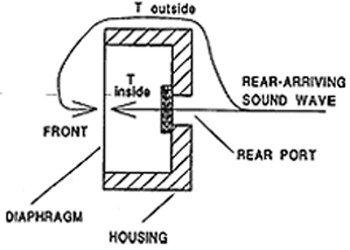As if by magic, cardioid microphones can pick up what they are aimed at, but reject sounds to the side and rear.
For example, talk into a cardioid mic from all sides while listening to its output. Your reproduced voice will be loudest when you talk into the front of the mic and softest when you talk into the rear.
Because they discriminate against sounds to the sides and rear, cardioid designs help reject unwanted sounds such as room acoustics (reverberation), feedback or leakage. For this reason, they’re the most popular microphone choice.
How do they work?
In other words, how do you make a mic directional?
Start by making it omnidirectional. Take a mic transducer, made of a diaphragm and some hardware that changes diaphragm motion into a signal. Then put this transducer in the end of a sealed can, so that incoming sound contacts the diaphragm only on its front surface.
Sound from the front presses on the front of the diaphragm and makes a signal. Sound from the side or rear bends around to the front of the mic.
This sound also presses on the front of the diaphragm and makes a signal. So the mic responds the same to sounds from all directions. In other words, it has an omnidirectional polar pattern (“omni” means “all”).
Note that the omni mic becomes directional at high frequencies. That’s because the mic housing blocks high frequencies that arrive off-axis.
Now suppose we put some holes in the can behind the diaphragm. We carefully size these holes and add acoustic damping such as felt or foam to create an acoustic phase-shift network.
It’s like an RLC circuit, which delays the signal passing through it. The holes, or the “rear ports,” let sound into the back of the diaphragm. Also, the ports delay the sound reaching the back of the diaphragm.

How does this arrangement cancel sound from the rear? Suppose a sound wave approaches the mic from the rear. It travels to the diaphragm by two paths: outside the mic and inside the mic through the ports (Figure 1).
Some of the sound wave travels to the front of the diaphragm, outside the mic. The sound travel time, from the rear port location to the front, we will call T.
Some sound also enters the rear ports and is delayed. If the delay inside the mic is set the same as the delay outside the mic, sounds arrive at the front and rear of the diaphragm at the same time, in phase.
Sounds push on opposite sides of the diaphragm, also in phase. The diaphragm cannot move, so sounds from the rear make a very weak signal. Rear sounds cancel out. You have created a cardioid polar pattern.
Sounds coming from the front do not cancel out. Why? Frontal sound waves travel to the rear ports during time T. Inside the mic, the phase-shift network further delays the sound by time T. The total delay is 2T. Since there is a big delay or phase shift between the signals at the diaphragm’s front and rear, a frontal sound makes a strong signal.
High frequencies do not reach the rear of the diaphragm because they are filtered out by the rear port’s RLC filter. The cardioid mic is directional at high frequencies because its housing blocks high frequencies off-axis.
How about a bi-directional ribbon mic? The ribbon is fully open to sound on its front and rear. Sounds from the front and rear experience a phase shift as they travel around the ribbon, so you get an output signal.
But sounds from the side press equally on the front and rear of the ribbon, in phase. The ribbon cannot move, so you get a weak output from side sounds.
By changing the delay of the rear ports, you can get almost any pattern between bidirectional and cardioid, such as supercardioid or hypercardioid. Each of these two patterns has a rear lobe that is in opposite polarity with the front lobe.
There’s a lot to know about microphones. If you’re unsure about their use and application, check out other articles in Microphone World here on PSW.
More articles by Bruce Bartlett on PSW:
Recording Microphone Techniques To Produce Warm, Spacious Stereo
Remastering Jazz Classics: The Dave Brubeck Quartet, Art Pepper, and Sonny Rollins
Deconstructing Hip-Hop To Hear How The Mix Comes Together




















